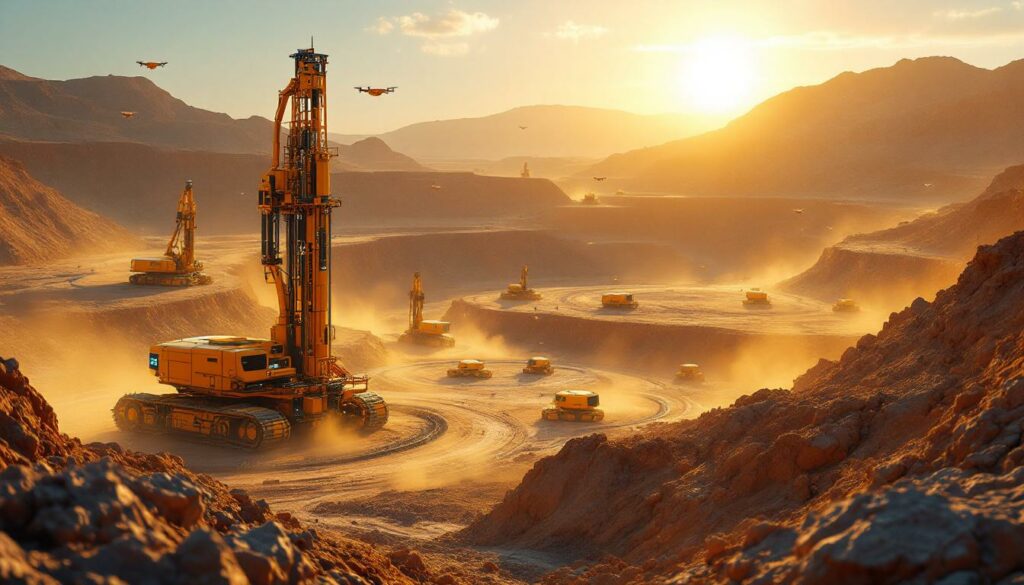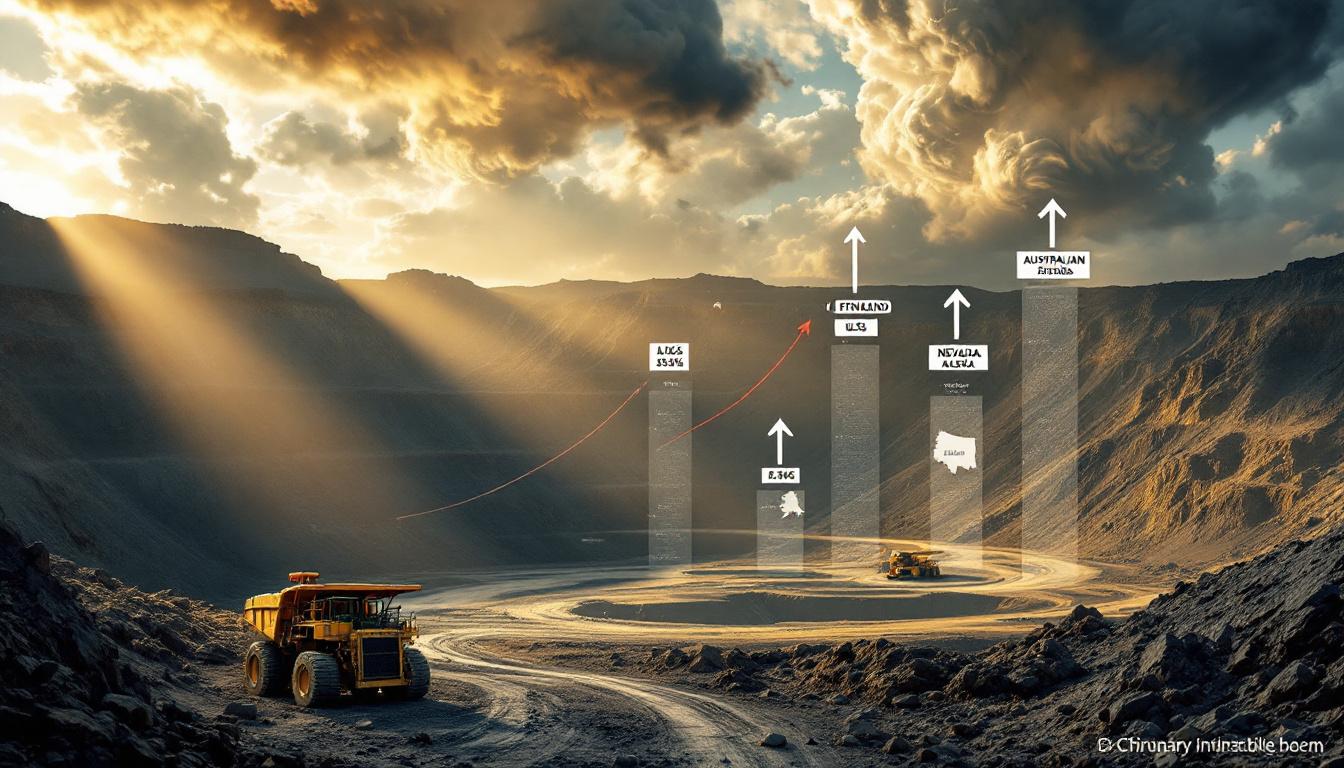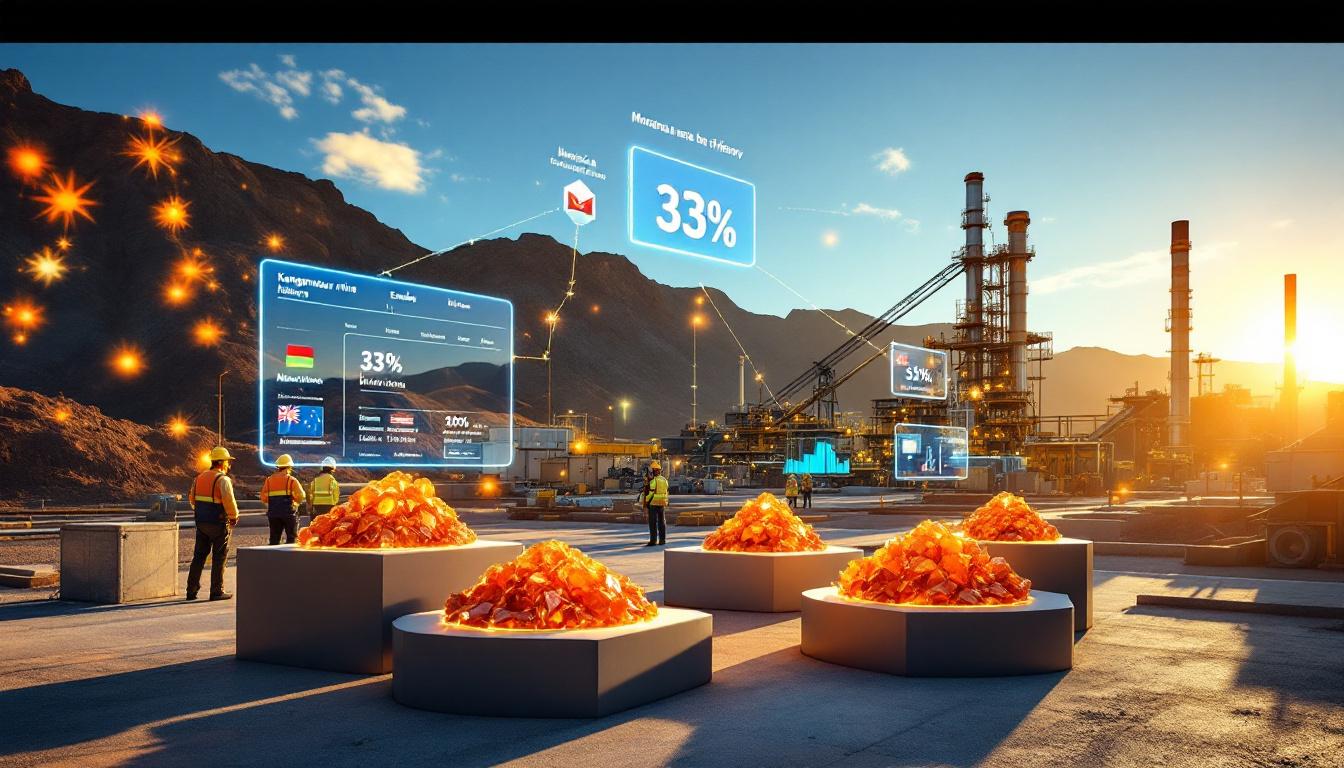Revolutionizing Remote Drilling: Sandvik Launches AutoMine Surface Fleet
Sandvik's AutoMine Surface Fleet represents a groundbreaking advancement in autonomous mining technology, enabling operators to control multiple drill rigs remotely from any connected location. This innovation is transforming surface drilling operations by delivering enhanced safety, efficiency, and productivity in ways previously unattainable with conventional drilling methods.
According to Sandvik's 2025 product launch data, the system enables a single operator to manage more than 15 surface i-series drill rigs simultaneously—a capability that fundamentally changes the economics and operational dynamics of data-driven mining operations worldwide.
"This system redefines scalability by merging AutoCycle's autonomy with fleet-wide coordination, eliminating human proximity to high-risk zones," notes Sandvik's Product Line Manager in their May 2025 press release.
The technology has already demonstrated its effectiveness during a comprehensive 14-month field validation at Boliden's Kevitsa mine in Finland, where the system maintained continuous operations even during challenging environmental conditions that would have halted conventional drilling operations.
How Does AutoMine Surface Fleet Work?
The AutoMine Surface Fleet operates through three integrated technological frameworks that enable unprecedented remote control capabilities.
Autonomous Multi-Rig Coordination
The system's core functionality allows a single operator to simultaneously manage more than 15 Sandvik surface i-series drill rigs from a remote location. This represents a 5:1 reduction in required operators compared to conventional methods, according to Sandvik's implementation data.
The coordination is powered by an AI-driven drilling innovation that intelligently allocates drilling tasks based on real-time rig positions, drill patterns, and operational priorities. This smart allocation ensures optimal utilization of all equipment while preventing operational conflicts.
Each rig maintains positional awareness through redundant positioning systems with accuracy within 2 centimeters, enabling precise hole placement even in complex drill patterns.
Integration with AutoCycle Technology
AutoMine Surface Fleet integrates seamlessly with Sandvik's proven AutoCycle capabilities, creating a sophisticated system that enables continuous drilling operations with minimal human intervention.
The integration reduces manual interventions by approximately 85% during hole transitions, according to field tests at Kevitsa. This is achieved through automated:
- Drill positioning and stabilization
- Rod handling and bit changes
- Collision avoidance and path planning
- Real-time adaptation to ground conditions
"The system's predictive algorithm recalculates drill paths when encountering unexpected hard rock formations," explains a Boliden Automation Engineer who participated in the implementation trials.
This intelligent adaptation ensures consistent drilling performance regardless of geological variability, maintaining productivity even when encountering challenging ground conditions.
Universal Control Station Compatibility
The AutoMine Surface Fleet is fully integrated with the AutoMine universal station, providing operators with a comprehensive interface for monitoring and controlling both boom and rotary drills simultaneously.
The control station features:
- Multi-display visualization of all active drill operations
- Real-time telemetry and performance metrics
- Intuitive control interfaces with haptic feedback
- Drill pattern management and modification tools
- Exception handling and intervention protocols
The universal compatibility ensures that mining operations can standardize their remote operation centers regardless of the specific drill types deployed across their sites.
Communication between the control station and rigs occurs through dual-redundant LTE/5G networks with latency under 50ms, enabling rapid response times for critical safety functions and collision avoidance.
What Are the Key Benefits of AutoMine Surface Fleet?
The AutoMine Surface Fleet delivers multiple operational advantages that collectively transform the economics, safety, and efficiency of surface drilling operations.
Enhanced Operational Efficiency
By enabling a single operator to manage multiple rigs simultaneously, mining operations can significantly reduce labor requirements while maintaining or increasing drilling productivity.
Based on data from the Kevitsa implementation, this technology delivers:
- 40% lower drilling costs per meter compared to conventional operations
- 35% increase in productive drilling time through elimination of shift changes at drill locations
- 92% equipment utilization rate, significantly higher than industry averages
- Reduced cycle times through optimized drill patterns and autonomous positioning
These efficiency gains translate directly to improved cost structures and higher production throughput with existing equipment fleets.
Improved Safety Through Remote Operation
The most significant benefit of AutoMine Surface Fleet is the complete removal of operators from potentially hazardous drilling environments.
The Mining Safety Institute recognizes that "remote operation is the single most effective hazard control for surface drilling," as it eliminates exposure to:
- Rock falls and unstable ground conditions
- Dust inhalation and associated respiratory risks
- Noise-induced hearing damage
- Vibration-related musculoskeletal disorders
- Extreme weather conditions and heat stress
- Blasting zone proximity risks
Personnel instead work from climate-controlled, ergonomically designed remote stations with consistent environmental conditions, reducing fatigue and enhancing decision-making quality.
Adaptability to Challenging Conditions
The AutoMine Surface Fleet is engineered to maintain consistent performance in extreme environmental conditions and complex geological settings that might otherwise impact operator comfort or safety.
At Boliden Kevitsa, the system demonstrated 99.2% hole placement precision even during winter operations at temperatures below -25°C. The site manager reported that "the system maintained 92% utilization during blizzards where manual operations halted."
This adaptability is enabled by sophisticated sensor arrays that adjust drilling parameters in real-time based on:
- Ground hardness and fracture patterns
- Ice or water presence in blast holes
- Excessive dust conditions
- Wind speed and direction
- Ambient temperature fluctuations
These adaptive capabilities ensure continuous operations in environments that would typically reduce conventional drilling productivity or require complete shutdowns.
Scalable Autonomous Operations
Mining companies can incrementally expand their autonomous drilling capabilities by adding compatible rigs to their existing fleet without proportional increases in operator headcount.
This scalability creates significant economies of scale:
| Conventional Operations | AutoMine Surface Fleet |
|---|---|
| 1 operator per rig | Up to 15 rigs per operator |
| Linear cost scaling | Diminishing marginal cost |
| Limited by shift patterns | 24/7 continuous operation |
| Consistent training needs | Concentrated expertise |
The system's architecture also allows for phased implementation, enabling operations to gradually transition to autonomy while maintaining production targets and managing change effectively.
How Has AutoMine Surface Fleet Been Tested?
The AutoMine Surface Fleet has undergone rigorous testing to validate its performance, reliability, and safety before commercial deployment.
Real-World Implementation at Boliden Kevitsa
The system underwent a comprehensive 14-month stress test at Boliden's Kevitsa mine in Finland, demonstrating its effectiveness in an actual production environment.
This open-pit copper and nickel operation presented ideal testing conditions due to:
- Variable ground conditions with multiple ore types
- Extreme seasonal weather variations
- Complex drill patterns for grade control
- Existing digital infrastructure compatibility
- Progressive management approach to innovation
The implementation involved a phased approach, starting with three rigs and gradually expanding to control of 22 drills across a 4 square kilometer operational area without production disruptions.
Performance Under Pressure
During testing at Kevitsa, the AutoMine Surface Fleet maintained drilling precision and productivity while operating multiple rigs simultaneously, proving its capability to handle complex coordination tasks.
Performance metrics from the trial included:
- 99.2% hole placement accuracy even in adverse weather conditions
- Consistent penetration rates across varying rock hardness
- Smooth transitions between holes with minimal repositioning time
- Automated exception handling for common drilling challenges
- Successful coordination of multiple simultaneous drilling operations
The system was also subjected to over 500 simulated failure scenarios, including GPS signal jamming, communications interruptions, and sensor failures, with appropriate fail-safe responses demonstrated in each case.
Safety and Reliability Verification
The trials confirmed the system's ability to maintain operational safety protocols while executing autonomous drilling functions.
Safety verification included:
- Compliance with ISO 17757:2019 standards for autonomous machine safety
- Successful detection and avoidance of unplanned obstacles
- Appropriate responses to simulated emergency scenarios
- Secure communications with FIPS 140-2 encrypted data tunnels
- Effective integration with site-wide emergency response systems
One notable real-world test occurred when lightning struck near the operation, temporarily disabling two rigs. The system automatically executed appropriate shutdown procedures and recovery protocols without operator intervention, demonstrating its resilience to unexpected disruptions.
What Technology Underpins the AutoMine Surface Fleet?
The AutoMine Surface Fleet leverages multiple advanced technologies to enable its autonomous capabilities and ensure reliable, safe operation.
Advanced Sensing and Positioning Systems
The system utilizes sophisticated sensors and positioning technology to maintain precise drill placement and operational awareness across multiple machines simultaneously.
Key sensing technologies include:
- LiDAR and millimeter-wave radar for high-precision positioning (<2cm accuracy)
- Multi-constellation GNSS with RTK correction for absolute positioning
- Inertial measurement units for continuous orientation awareness
- Machine vision systems for obstacle detection and verification
- Drill performance sensors monitoring bit pressure, rotation, and penetration rate
These sensors generate approximately 1.2 terabytes of data per hour for each operational rig, creating a comprehensive digital representation of the drilling environment and machine status.
Robust Communication Infrastructure
A secure, high-bandwidth communication network enables real-time data transmission between the control station and multiple drill rigs, ensuring responsive control and continuous monitoring.
The communication architecture features:
- Dual-redundant LTE/5G networks with automatic failover
- Low-latency protocols (<50ms) for critical safety functions
- Bandwidth prioritization for control commands over telemetry
- Store-and-forward capabilities during temporary connectivity issues
- End-to-end encryption meeting FIPS 140-2 standards
This infrastructure ensures reliable command transmission even in challenging electromagnetic environments with potential interference from other mining equipment.
Intelligent Automation Algorithms
Proprietary software coordinates the activities of multiple drills, optimizing drill patterns, managing transitions between holes, and adapting to changing ground conditions without constant operator input.
According to Sandvik's CTO, "Our swarm intelligence allows rigs to share terrain data in real time, creating collective 'awareness' that benefits the entire fleet."
The algorithmic approach includes:
- Reinforcement learning for optimized drill path planning
- Pattern recognition for identifying problematic ground conditions
- Predictive maintenance algorithms monitoring equipment health
- Dynamic resource allocation to maximize fleet productivity
- Automated exception handling for common drilling challenges
These algorithms continuously improve through machine learning, with each operational hour providing additional data for optimization and adaptation to site-specific conditions.
What Does This Mean for the Future of Surface Mining?
The AutoMine Surface Fleet represents a significant step toward fully autonomous mining operations, with far-reaching implications for the industry's future.
Evolving Workforce Requirements
As autonomous drilling technology advances, mining operations will likely shift toward higher-skilled technical roles focused on system management rather than direct machine operation.
The World Economic Forum's 2024 Mining Report projects a 60% reduction in conventional drill operators by 2030, counterbalanced by growth in:
- Remote operations specialists
- Data analysts and mining intelligence experts
- Autonomous system technicians
- Predictive maintenance engineers
- Drilling optimization specialists
"Autonomy isn't about job loss—it creates high-value roles in data analytics and remote ops," explains the CSIRO Mining Director in their 2025 industry outlook.
This transformation presents both challenges and opportunities for mining companies, requiring proactive workforce development strategies and training programs to ensure successful transitions.
Increased Operational Continuity
Autonomous drilling enables 24/7 operations with reduced shift changeover disruptions, potentially increasing overall equipment utilization and production volumes.
McKinsey's 2024 mining productivity analysis indicates that continuous autonomous operations can boost output by approximately 35% compared to conventional shift-based approaches.
This continuity creates advantages including:
- Elimination of shift handover inefficiencies
- Consistent drilling performance regardless of time of day
- Reduced equipment startup/shutdown cycles
- More efficient blast pattern completion
- Improved coordination with downstream processes
For mining operations with processing plants designed for continuous operation, this alignment of upstream drilling activities creates smoother production flows and more predictable ore delivery.
Integration with Mine-Wide Digital Ecosystems
The AutoMine Surface Fleet represents another component in the growing digital integration of mining operations, potentially connecting with fleet management, grade control, and production planning systems.
Through standardized APIs, the system can interface with:
- MinePlan® and other 3D geological modelling tools
- Fleet management systems for holistic equipment coordination
- Fragmentation analysis for blast optimization
- Grade control and ore tracking systems
- Production scheduling and modern mine planning software
This integration creates a comprehensive digital ecosystem where drilling data directly informs downstream processes, creating opportunities for whole-of-mine optimization previously impossible with siloed operational systems.
FAQ About Autonomous Drilling Technology
How does autonomous drilling compare to conventional methods in terms of accuracy?
Autonomous drilling systems typically maintain equal or superior hole placement accuracy compared to manual operation. Data from the Kevitsa implementation demonstrated 99.2% hole placement precision even in adverse weather conditions, exceeding the typical 95-97% accuracy range of conventional operations. This consistency stems from precise positioning technology and elimination of human variability between shifts.
Additionally, the system maintains more consistent depth control and verticality than manual operation, particularly in deep holes where deviation can significantly impact blast effectiveness.
What training is required for operators to manage multiple autonomous drill rigs?
Operators require specialized training focused on system management rather than traditional drilling skills. Typical training programs include:
- Remote monitoring interface familiarization (1-2 weeks)
- Exception handling and intervention protocols (1 week)
- Drill pattern implementation and modification (1 week)
- System diagnostic and troubleshooting procedures (1 week)
- Simulation-based scenario training (1-2 weeks)
While the physical skills needed for direct rig operation become less critical, operators develop advanced capabilities in pattern optimization, drill performance analysis, and coordinated fleet management.
Can autonomous drilling systems adapt to unexpected ground conditions?
Modern autonomous drilling systems incorporate adaptive algorithms that can detect changes in ground conditions and adjust drilling parameters accordingly.
The AutoMine Surface Fleet specifically monitors:
- Penetration rate variations indicating hardness changes
- Torque fluctuations suggesting fracture zones
- Vibration patterns identifying unstable formations
- Water or void detection through pressure changes
- Rod binding or sticking conditions
When conditions exceed programmed parameters, the system either adjusts automatically within established limits or alerts the remote operator for intervention decisions, depending on the severity of the deviation.
What infrastructure is needed to implement autonomous drilling at a mine site?
Implementation typically requires several key infrastructure elements:
-
Communications network: High-bandwidth, low-latency coverage across the operational area, typically using LTE/5G technology with appropriate redundancy
-
Positioning infrastructure: RTK base stations or equivalent precision positioning network with site-wide coverage
-
Remote operations center: Climate-controlled facility with appropriate ergonomics, visualization systems, and backup power
-
Compatible drill rigs: Surface i-series or similarly equipped units with automation-ready control systems
-
Integration interfaces: API connections to existing mine planning and fleet management systems
-
Site preparation: Clear delineation of autonomous operating zones and appropriate safety barriers or systems
The investment in this infrastructure typically delivers returns through increased productivity, reduced operating costs, and improved safety performance within 12-18 months, according to Sandvik's autonomous drill operations implementation data.
As the mining industry continues to embrace evolving mining innovation, technologies like the AutoMine Surface Fleet are revolutionising remote drilling operations and setting new standards for productivity, safety, and operational excellence.
Disclaimer: This article contains forward-looking statements regarding mining technology and workforce impacts. Actual implementation results may vary based on site-specific conditions, regulatory environments, and organizational factors. Mining companies should conduct thorough feasibility studies before implementing autonomous drilling systems.
Want to Get Ahead of Major Mineral Discoveries?
Discovery Alert's proprietary Discovery IQ model delivers instant notifications about significant ASX mineral announcements, giving you a crucial edge in the market. Explore how historic discoveries have generated substantial returns by visiting our dedicated discoveries page and start your 30-day free trial today.




